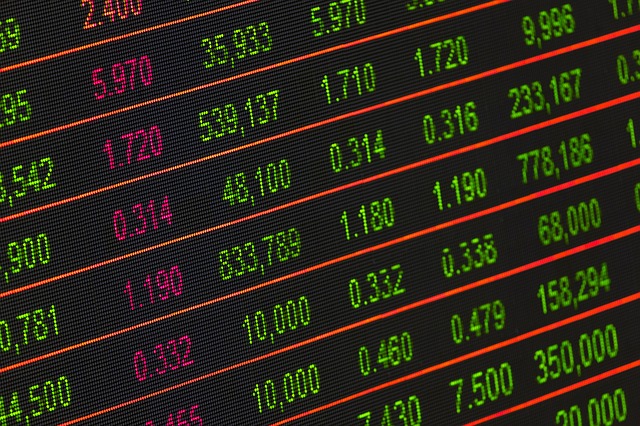Top Blue Chip Stocks, Dividend Stocks and more
View a list of top stocks on NASDAQ and NYSE
Stock Forecasts, Price Charts, Annual Reports and More
Stock Forecasts, Technical Analysis, Price Charts and More
Best Stocks Under $100
More Stock Tools
Hottest Stocks Right Now
Most Volatile Stocks For Day Trading
The stock market has always been volatile, and shocks like the turn of the decade global pandemic and subsequent market crash made it clear it always will be.
As the virus spread across the globe, countries and cities implemented shutdown orders that effectively strangled profitability for businesses in industries like retail, manufacturing, fitness, travel, and more. Even healthcare was affected, as people avoided hospitals out of either lack of money or fear of catching Covid-19.
But stock volatility isn’t anything new. It’s always been there – we just mitigate the risk through successful investment strategies and diversification through ETFs that mimic indices like the S&P 500 or Dow Jones Industrial Average.
But the big money with massive gains has always been in day trading volatile stocks. From penny stocks to biotech companies, these unstable investments can lose or gain multiples of 10x in a single day. This makes trading them lucrative, but they also comes with risk.
You stand to lose as much as you gain by day trading a volatile market. It’s not for the weak of heart, but if you can stomach the quick thinking and acting it takes to be successful, you can become one of the wolves of Wall Street. Let’s tackle market volatility to see how successful traders navigate the turbulent waters.
What Is Stock Volatility?
Financial markets ebb and flow, and the value of something considered “stable” like the U.S. Dollar is relative to the times.The volume of gas $1 bought you in 1970, 2000, and 2020 were vastly different, and you can find different gas prices throughout your city.
The exchange rate between a U.S. Dollar and other international fiat currencies also fluctuates, creating problems for businesses paying employees in different countries.
On top of this, the stock market and other investments grow at a different rate then the currency and commodity markets.
The dispersion statistically of returns for a given stock or stock market index represents stock volatility.
A skilled investor is able to implement the simple strategy of “buy low – sell high,” to generate a profit. For long-term investment portfolios like a 401K or other retirement plan, stable investments are sought.
These are typically done through established indices that vet companies for performance to outperform the dollar. This is a diversification strategy that doesn’t depend on one single investment.
You can think of stock volatility as being used to describe a single security’s performance against the rest of the market. Volatile stocks aren’t guaranteed to last until you retire, and their value drastically changes at any given moment.
Often this occurs with smaller, less established companies that trade on over-the-counter (OTC) markets. These investments are also known as penny stocks, as they trade for pennies (actually under $5) per share.
Penny stocks are volatile, because smaller companies typically don’t release detailed financial statements publicly.
Their moves are less widely covered by the media, and you often know less about them. This isn’t always the case though, as some popular brands you know, like Nintendo, trade on OTC markets. So, let’s discuss how to identify volatile stocks.
How to Identify Volatile Stocks
All stocks are investments in companies, and the market conditions those companies face impact their profitability. A large corporation like McDonald’s (MCD) can more accurately forecast its profitability than your local mom-and-pop diner with only a handful of locations at best. But size isn’t everything, and some markets can create volatility just by their nature.Nearly every stock was volatile in 2020, but there are volatile stocks even in the best of times. Cannabis, vaping, and cryptocurrency are three industries that rose to prominence in the 2010s.
Each had a range of different investment opportunities due largely to questions surrounding their legality. Because they’re so prominent, they make great examples to illustrated how to identify stock volatility.
1. Cannabis Market Volatility
Investing in cannabis is getting easier than ever, with apps like Robinhood even allowing it. But it wasn’t always this way, and it’s still a volatile investment.This is because cannabis is still federally illegal heading into the November 2020 election, despite being legal in one form or another in nearly every state.
Its federal classification as a Schedule I narcotic means that investing in recreational and medical cannabis can’t be done by U.S. exchanges.
However, many American cannabis companies like Harvest Health & Recreation Inc (OTCMKTS:HRVSF) sell on OTC markets and the Toronto Stock Exchange (TSX), while Aurora Cannabis Inc (NYSE:ACB) got listed on the NY Stock Exchange because it operates outside the U.S.
There are new cannabis laws getting voted on the books somewhere in this country every year, whether by legislature or the voting public. Each law has an impact on cannabis stocks, which are already volatile because they’re based on harvests.
Growing cannabis (whether THC-rich marijuana or CBD-rich hemp) is a difficult and expensive task, and profits in this sector will always be volatile, even if made federally legal. We’ve already seen this in vaping.
2. Vaping Market Volatility
The vaping market exploded in the 2010s, with companies like Juul (in which Altria has a stake) jumping to a $38 billion valuation before a vaping crisis hit.A lung injury outbreak that impacted younger vapers rocked the industry and created instability, even for more established public tobacco companies involved.
This vaping crisis renewed backlash against tobacco companies and caused legislation that banned flavored vapes and other tobacco products (like certain flavored cigars and cigarettes).
Investing in this market is guaranteed to be volatile, as vaping regulations continue to sweep through municipalities across the nation. Still, the industry isn’t taking it lying down and continues innovating to pull itself up through the chaos.
Now that you understand some of the factors that create a volatile market, let’s dig into how to trade these volatile stocks.
3. Cryptocurrency Market Volatility
The crypto market is largely dependent on Bitcoin (BTC), as it’s the first and most prominent. While BTC itself is a currency comparable to the U.S. Dollar, many crypto assets are securities. The entire crypto market, however, tends to trend with Bitcoin, which went through its most volatile period to date from 2017-2018.Prior to this, one Bitcoin could be purchased for under $500. By the beginning of 2017, the price was over $1000. It reached its all-time high price of $19,783 by December 2017 and spent the next two years deflating below $10,000.
The turbulent market made early whale investors like the Winklevoss twins, Changpeng Zhao, Joseph Lubin, and Chris Larsen billionaires. Many were able to diversify their investments into companies, investment firms, incubators, and more to generate value.
However, it was later discovered that the reason the market inflated so much in the first place was due to market manipulation involving a stablecoin called Tether (USDT). Regulators around the world began a process of wrangling the crypto industry in that’s still ongoing, and the market will remain unstable and turbulent for a long time to come.
How to Trade Volatility
Trading volatility is best done in short bursts, in what’s called day trading. The difference between a normal investor and a day trader is that a day trader is looking to squeeze profits out on a daily basis.This means they’re buying and selling stocks with quicker speed than a house flipper. In fact, a day-trader will often make several trades in the course of a day.
One key ingredient to seek in a volatile stock is trading volume. You need an investment that has a lot of trading volume so you’re able to easily buy and sell your investments as needed. If nobody is buying and you’re stuck holding the bag, it doesn’t matter how cheap you were able to get in at.
The other key to day trading is timing – you need an brokerage platform that can act quickly, so you can jump on an opportunity as fast as possible.
You’re often counting on seconds to make the difference between a big win and a loss. That’s because trading volatile markets isn’t as easy as just buying low and selling high. You can also incorporate futures (and options) into your investment strategy. This allows you to short the market, which means you earn money by betting on which stocks will lose value.
Betting against a stock by selling calls or going long through puts (or even an inverse ETF) are ways to counter stock volatility when you already hold a long (or bullish) position.
In fact, many successful investors even allocate a small percentage of their investments into an option that helps them mitigate losses should something unexpected happen to their investment. Options prices often get higher based on the expected implied volatility in the future. The more sensitive the price is, the more of a premium you may pay.
The downside to futures trading, however, is large negative balances. A 20-year-old investor committed suicide in June 2020 because his Robinhood account was left with a negative $730,000 balance through options trading.
While much of this debt was wiped out when the market adjusted, the inexperienced trader didn’t understand what he was doing. Make sure you only use options and trade volatile stocks if you understand the risk and consequences.
How to Screen for Volatile Stocks
There are two ways to screen for volatile stocks, which are to either seek historically volatile investments or investments with implied future volatility.The three markets mentioned above (cannabis, cryptocurrency, vaping) all qualify for both categories, but they’re not alone. There are volatile companies within every industry, and major market events like the coronavirus caused volatility across all markets.
The 2020 stock market crash was historic in its breadth, as the Dow fell a record 7.79 percent on March 9. On March 12, the DJIA dropped an additional 9.99 percent, and it fell another 12.93 percent on March 16.
In all, the market crashed nearly 20 percent from February highs, with eight of the 10 biggest one-day point losses in Dow Jones history occurring in these two months.
As mentioned above, you’re seeking stocks that have a lot of trading volume, so you’re able to buy and sell as needed. The last thing you need is to be holding a stock the day the underlying company goes out of business.
If you’re not familiar with the market and don’t want to spend all your time searching, you can also use automated trades through many brokers. These let you set specific limits and automatically execute trades when those limits are reached. These roboadvisors are also helpful in finding volatile stocks.
With apps like Robinhood, you can even create watch lists and sort by change percentages across a day, week, month, year, or five years.
This helps you rank the volatile stocks you find by their respective daily instability and pricing inflections. This brings us to the point of whether you should risk your money.
Should I Invest in Volatile Stocks?
The above story about a newbie trader misunderstanding options highlights just how risky day trading in volatile stocks can be.For some, day trading can become a pathological addiction that’s viewed as similar to gambling addition disorders.
If you have a highly addictive personality or rent is due and you can’t afford to lose any money, investing in volatile stocks isn’t for you.
Only invest what you’re willing to lose, as you’re very likely to lose money. Even experienced traders can lose their shirts, and it takes time to fully understand the market you’re trading.
Before diving into penny stocks, spend at least a week watching the market and doing a practice run on paper, similar to fantasy football. This simulation will show you how good your eye for the market is without risking any money.
This practice is recommended because of the inherent risk of trading volatile stocks.
Risks of Trading Stock Volatility
While day trading does present a “get rich quick” opportunity, it also represents a “go broke quick” one.Volatile stocks are unpredictable, and the market can wipe out most of your money in an instant. Day trading is also something that you need to get in and out of.
You probably don't want to leave your money in a volatile stock for a long period of time, as that’s almost going to guarantee you lose your investment.
This happened to a reporter for Men’s Health who attempted to follow in the footsteps of famed cannabis investor Jason Spatafora, known as the Wolf of Weed Street. The Wolf is adamant about his investment fundamentals, and the reporter lost his money by not listening to the advice.
Volatile Stocks for Day Trading
We don’t make specific stock recommendations, but we’ve already explained where you can find great stocks to day trade.They’re most often available on OTC markets as penny stocks, and they’re focused on smaller companies making bigger moves in riskier industries.
You can also invest in crypto assets, but be sure to check out trading fees to understand how much you’re spending on these.
Beyond that, you’re always welcome to try day trading an established stock like Amazon (AMZN) or Apple (AAPL). Even these heavy hitters hit turbulent waters in 2020 and had volatile pricing. In the 2020s, anything is possible.
Top Volatile Stocks to Buy
Volatile stocks can be found anywhere you look in 2020, but the best places to look are in OTC markets, cryptocurrency, and cannabis. These investments experience constant price fluctuations compared to the rest of the stock market and the U.S. Dollar. You can make or lose a lot of money in a single day of trading.The next way to find volatility is to invest leading up to companies reporting their quarterly and year-end financials. These shareholder meetings often cause pricing volatility. If you believe a company is going to announce profits, jumping in early and selling upon the announcement is a great “buy low – sell high” strategy to trade volatility.
The biggest gains (and biggest losses) are often in the smaller, emerging companies. Had you invested in something like Zoom (ZM) or Amazon (AMZN) heading into the 2020 coronavirus pandemic, you’d be a rich person today. Nobody can predict the future, but you can sometimes tell when the road looks rocky ahead.
Investing News

Is Splunk’s Rally a Glimmer of Hope or a Mirage?
Adrenaline junkies of the investing world, brace yourselves! Splunk (NASDAQ:SPLK), the company that once led the frontier of searchable unstructured business data, is back in the spotlight. A long-ignored wallflower in the dance of cloud analytics, Splunk is now drawing attention with its recent stock rally. The company’s free cash flow has solidified and GAAP […]

5 Stocks To Buy During Hurricane Season
Labor Day marks the unofficial end of summer. Schools reopen, leaves start to change color, and consumers begin looking towards autumn holidays. However, that’s not the only event associated with early September. The hurricane season peaks around Labor Day, and historically, there have been devastating storms all the way through September and well into October. […]

Will Moderna Stock Recover?
The global impacts of COVID-19 are finally easing. But in spite of the damage the pandemic inflicted on the economy at large, some companies directly benefited from COVID. Moderna (NYSE: MRNA) was one of those companies, and after the launch of its high-profile mRNA vaccine, the company’s revenue (and its stock) skyrocketed. Once trading at $18.60 […]

How To Buy Starlink Stock
Internet access is no longer a luxury. It’s a necessity for everything from healthcare to education. In developed countries like the United States, Canada, and most of Europe, it’s easy to get online. The equipment and infrastructure required for reasonably fast, reliable internet is in place throughout populated areas. In some cases, it’s even possible […]

VOOG Vs VOO: Which S&P 500 ETF Is Best?
Whether you’re new to investing or a long-time trader, having S&P 500 funds is almost a given in a well-rounded portfolio. But which S&P 500 ETF is best: VOO or VOOG? We take a look at two popular S&P 500 ETFs – VOOG and VOO to see what the differences between them are when it […]

Best AI Stock To Hold Long Term
Over the last few decades, no company has stood out as a bastion of growth and stability as much as the American tech corporation Microsoft (NASDAQ:MSFT). While its profitability and wide range of business interests have always made it a favorite among investors, the ongoing disruption in generative AI has positioned MSFT even more prominently […]
The #1 Stock Analysis Tool to Make Smarter Buy and Sell Decisions
Get started at Financhill, the #1 investment research platform that is your one-stop shop for finding the best trade ideas today.
-
Top Rated Stock Ideas
Financhill Stock Score is a proprietary stock rating engine that independently evaluates every company based on fundamental, technical, and sentiment criteria so you can find the highest rated stocks in the S&P 500, NASDAQ and NYSE. -
Best Stock Tools Platform
Whether you are looking for the best blue chip stocks, top dividend stocks, most shorted stocks, cheapest stocks today, highest dividend stocks or best stocks under $50, Financhill has got you covered and has so much more. -
Stocks Set To Soar & Crash
Financhill spots seasonal patterns in thousands of stocks so you can easily screen for the best stocks at this time of year. Want to know what stocks could rise 11% over the next 7 weeks with 91% accuracy based on past history? Our Seasonality Screener will surface the hottest stocks right now.